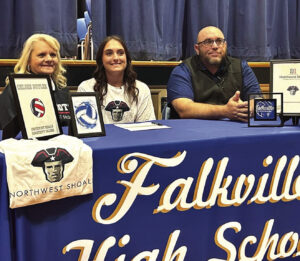
We’re all thumbody
Editor’s note: This is one in a series of articles marking the 50th Anniversary of Hartselle City Schools.
In Fall 2024, Hartselle City Schools was eval uated by the Title IX division of the Alabama State Department of Education. Though the majority of Hartselle’s programs are monitored every five years or so, it had been over 20 years since Title IX policies and procedures had been examined.
As part of the process of examining career tech classes (formerly known as vocational classes), a sampling of career tech students were interviewed at Hartselle High School, Hartselle Juinor High School, and Hartselle Intermediate School. The students knew they were going to be interviewed and they generally knew the types of questions that might be asked of them, so they did not enter the process completely naive. Still, the interviewers had interviewed a lot of students in a lot of schools over a lot of years, and they were particularly astute at assessing the day to day operations of a school or dis-trict based on student responses and reactions to questions.
I was part of the findings presentation when this team left HCS. They did not leave without a few recommendations for improvement. But what caught my ear even more than those recommendations was the time they spent talking about our students your children and grandchildren and neighbors. The team was charmed by these students’ comments regarding their schools, their classes, and their teachers; and they enjoyed the interactions the students had with one another. In short, the students seemed happy, and they seemed capable.
Back on September 30, 1993, the Hartselle Enquirer’s Angie Maples wrote an article entitled I’m Thumbody: Third Graders Learn Self-Esteem. Hartselle’s principals, guidance counselors, teachers and PTOs pooled their ideas and resources with the Mental Health Association of North Central Alabama to offer seven-year-olds encouraging lessons in developing and maintaining a positive self-image and believing in themselves.
The lessons included acknowledging that not every student in the classroom looked the same and that not every student had the same gifts and talents, but the lessons also worked to provide students with strategies for self-soothing when they felt “down in the dumps.” The main character in the lessons was Thumbody who looked very much like a unique thumbprint.
When a Thumbody lesson was dismissed, the students recited a poem together. One line of the poem was “No one sees the things I see; behind my eyes is only me.” In the thirty years that have passed since that program began, additional attention has been focused on student agency. Step one in developing agency is recognizing that every member of a team has a role and likely brings a unique skill to that role, and step two involves each student recognizing his or her own significance and responsibility to the team, but the added step three is all about learning how to contribute.
Much of what is written about developing agency in students focuses on schools providing opportunities for engagement, building routines toward problem-solving, ensuring access to information and developing judment in evaluating that information, supporting informed theories and supporting opinions based on gathered information, and then honestly evaluating outcomes and making changes where they are needed. Consensus-building is also a part of the process because it is a part of life.
And so, the groups of students interviewed in 2024 benefited from the Thumbody lessons of 1993 that established a foundation upon which today’s character development lessons are constructed. The result? A team of savvy professionals walking away from student interviews with a good feeling about the kids in the room and the schools educating them.
Makes me feel pretty good for the community that serves them, too. They will be serving us next.















